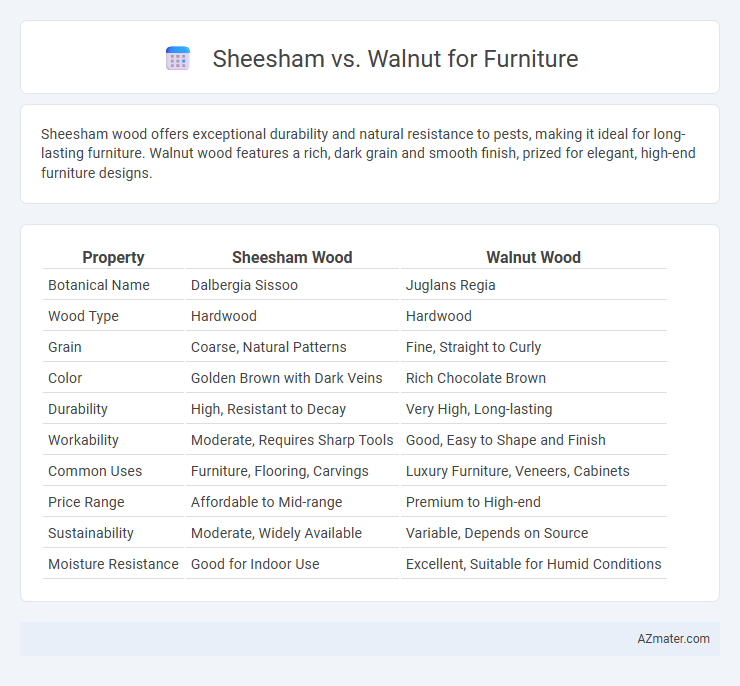Sheesham wood offers exceptional durability and natural resistance to pests, making it ideal for long-lasting furniture. Walnut wood features a rich, dark grain and smooth finish, prized for elegant, high-end furniture designs.
Table of Comparison
| Property | Sheesham Wood | Walnut Wood |
|---|---|---|
| Botanical Name | Dalbergia Sissoo | Juglans Regia |
| Wood Type | Hardwood | Hardwood |
| Grain | Coarse, Natural Patterns | Fine, Straight to Curly |
| Color | Golden Brown with Dark Veins | Rich Chocolate Brown |
| Durability | High, Resistant to Decay | Very High, Long-lasting |
| Workability | Moderate, Requires Sharp Tools | Good, Easy to Shape and Finish |
| Common Uses | Furniture, Flooring, Carvings | Luxury Furniture, Veneers, Cabinets |
| Price Range | Affordable to Mid-range | Premium to High-end |
| Sustainability | Moderate, Widely Available | Variable, Depends on Source |
| Moisture Resistance | Good for Indoor Use | Excellent, Suitable for Humid Conditions |
Introduction to Sheesham and Walnut Wood
Sheesham wood, also known as Indian rosewood, is prized for its rich grain patterns and natural luster, making it a popular choice for durable and aesthetically appealing furniture. Walnut wood, valued for its deep chocolate-brown color and straight grain, offers strength and smooth texture ideal for premium furniture pieces. Both woods are hardwoods with excellent resistance to wear and environmental changes, but Sheesham showcases a more prominent grain while Walnut is favored for its uniform finish.
Botanical Origins and Timber Sources
Sheesham, also known as Dalbergia Sissoo, is a deciduous tree native to the Indian subcontinent, prized for its dense, durable timber commonly sourced from sustainably grown plantations in India and Pakistan. Walnut, primarily Juglans regia (English Walnut), originates from the temperate regions of Europe and Asia, with timber harvested mostly from managed forests in North America and Europe. Both timbers are valued in furniture making for their distinct grain patterns and strength, but their botanical origins influence the wood's coloration, texture, and workability.
Physical Appearance and Grain Patterns
Sheesham wood features rich golden to dark brown hues with deep, contrasting grain patterns that create a warm, rustic appeal, often showcasing natural oiliness that enhances its sheen. Walnut exhibits a smooth, fine grain with a rich chocolate brown color and occasional purplish cast, giving furniture a sleek, luxurious appearance. Both woods offer distinct, attractive grain patterns, but Sheesham tends to display more variation and texture, while Walnut is prized for its uniformity and elegance.
Durability and Strength Comparison
Sheesham wood, known for its dense grain and natural oils, offers remarkable durability, resisting decay and termite attacks, making it ideal for long-lasting furniture. Walnut wood is prized for its strength and stability, providing a robust structure that supports heavy loads without warping or cracking. Comparing durability, Sheesham's natural resistance to moisture and pests often outlasts walnut in humid conditions, while walnut excels in strength and shock resistance, suitable for fine furniture requiring both toughness and elegance.
Workability and Ease of Crafting
Sheesham wood offers excellent workability due to its medium density and natural oils, making it easier to carve and shape without excessive wear on tools. Walnut, renowned for its smooth grain and fine texture, provides superior ease of crafting, especially for detailed joinery and intricate designs. Both woods perform well in furniture making, but walnut's consistent grain structure often yields a more refined finish with less sanding effort.
Resistance to Termites and Decay
Sheesham wood exhibits significant natural oils that provide strong resistance to termites and decay, making it a durable option for furniture in humid climates. Walnut, while prized for its rich color and grain, is less resistant to termite infestation and decay, requiring additional treatment for outdoor or high-moisture environments. For long-lasting furniture, especially in termite-prone areas, Sheesham offers better protection and longevity compared to Walnut.
Maintenance and Longevity
Sheesham wood offers excellent durability with natural resistance to pests and requires minimal maintenance, making it ideal for long-lasting furniture in humid environments. Walnut wood provides superior aesthetic appeal with a smooth finish but demands regular care, such as polishing and protection from moisture, to maintain its longevity. Both woods benefit from periodic oiling, but Sheesham's natural oils contribute to easier upkeep and extended lifespan compared to walnut.
Cost Differences and Market Availability
Sheesham wood, also known as Indian Rosewood, is generally more affordable than walnut, making it a popular choice for budget-conscious furniture buyers. Walnut wood commands higher prices due to its rich color, fine grain, and stronger market demand in premium furniture segments. In terms of market availability, Sheesham is more widely available in South Asia and parts of the Middle East, while walnut is commonly sourced from North America and Europe, influencing both regional costs and accessibility.
Best Furniture Applications for Each Wood
Sheesham wood, known for its rich grain and durability, is ideal for sturdy furniture pieces like cabinets, wardrobes, and dining tables that require heavy use and resistance to wear. Walnut wood, prized for its fine texture and elegant finish, excels in crafting high-end furniture such as desks, bed frames, and decorative veneers, offering a luxurious aesthetic with ease of carving. Both woods provide excellent longevity, but Sheesham suits robust, everyday furniture, while walnut is preferred for sophisticated designs and intricate detailing.
Final Verdict: Choosing Between Sheesham and Walnut
Sheesham offers durability and rich grain patterns at a more affordable price, making it ideal for traditional and rustic furniture designs. Walnut stands out with its luxurious dark tones and smooth finish, favored for high-end, modern pieces requiring strength and elegance. For budget-conscious buyers seeking warmth and resilience, Sheesham is the go-to, while Walnut suits those prioritizing refined aesthetics and prestigious appeal.

Infographic: Sheesham vs Walnut for Furniture
 azmater.com
azmater.com